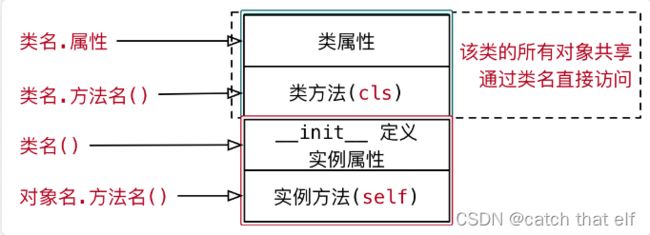Python笔记09-类属性、类方法和静态方法
文章目录
- 类的结构
- 类属性
- 类方法
- 静态方法
类的结构
使用面相对象开发,第 1 步 是设计 类
然后使用 类名() 创建对象,创建对象 的动作有两步:
- 在内存中为对象 分配空间
- 调用初始化方法 init 为 对象初始化
对象创建后,内存 中就有了一个对象的 实实在在 的存在 —— 实例
在程序执行时:对象各自拥有自己的 实例属性,可以通过 self.访问自己的属性、调用自己的方法
每一个对象 都有自己 独立的内存空间,保存各自不同的属性
多个对象的方法,在内存中只有一份,在调用方法时,需要把对象的引用 传递到方法内部进行调用
Python 中 一切皆对象
class AAA: 定义的类属于 类对象
obj1 = AAA() 属于 实例对象
在 Python 中,类 是一个特殊的对象 —— 类对象
在程序运行时,类对象 在内存中 只有一份,使用 一个类 可以创建出 很多个对象实例
除了封装 实例 的 属性 和 方法外,类对象 还可以拥有自己的 属性 和 方法
通过 类名. 的方式可以 访问类的属性 或者 调用类的方法

类属性
类属性 是针对 类对象 定义的属性使用 赋值语句 在 class 关键字下方可以定义 。用于记录 与这个类相关 的特征
class Tool(object):
# 使用赋值语句,定义类属性,记录创建工具对象的总数
count = 0
def __init__(self, name):
self.name = name
# 针对类属性做一个计数+1
Tool.count += 1
# 创建工具对象
tool1 = Tool("斧头")
tool2 = Tool("榔头")
tool3 = Tool("铁锹")
# 知道使用 Tool 类到底创建了多少个对象?
print("现在创建了 %d 个工具" % Tool.count)
class Test:
count=10 #类属性
def __init__(self):
self.count=100
test = Test()
print(Test.count,"===",test.count)#10 === 100
属性的获取机制
在 Python 中 属性的获取 存在一个 向上查找机制,因此,要访问类属性有两种方式:
类名.类属性
对象.类属性 (不推荐)
如果使用 对象.类属性 = 值 赋值语句,只会 给对象添加一个属性,而不会影响到 类属性的值

class Test:
count=10 #类属性
def __init__(self):
self.__count=100
#self.count=11
test = Test()
#test.count=12
print(Test.count,"===",test.count)#10 === 10
类方法
类方法 就是针对 类对象 定义的方法,在 类方法 内部可以直接访问 类属性 或者调用其他的 类方法
语法如下
@classmethod
def 类方法名(cls):
pass
示例
class Test:
count=10 #类属性
def __init__(self):
self.__count=100
#self.count=11
@classmethod
def name(self):
print("====",self.count,self.__count)# 'Test' has no attribute '_Test__count'
test = Test()
test.name()
类方法需要用 修饰器 @classmethod 来标识,告诉解释器这是一个类方法
类方法的 第一个参数 应该是 cls,由 哪一个类 调用的方法,方法内的 cls 就是 哪一个类的引用
这个参数和 实例方法 的第一个参数是 self 类似, 使用其他名称也可以,不过习惯使用 cls
通过 类名. 调用 类方法,调用方法时,不需要传递 cls 参数
可以通过 cls. 访问类的属性、调用其他的类方法
静态方法
在开发时,如果需要在 类 中封装一个方法,这个方法:
既 不需要 访问 实例属性 调用 实例方法
也 不需要 访问 类属性调用 类方法
这个时候,可以把这个方法封装成一个 静态方法
@staticmethod
def 静态方法名():
pass
静态方法 需要用 修饰器 @staticmethod 来标识,告诉解释器这是一个静态方法
通过 类名. 调用 静态方法
class Test:
count=10 #类属性
def __init__(self):
self.__count=100
#self.count=11
@classmethod
def name(self):
print("====",self.count,self.__count)# 'Test' has no attribute '_Test__count'
@staticmethod
def name():
print("====static method")# 'Test' has no attribute '_Test__count'
test = Test()
Test.name()
